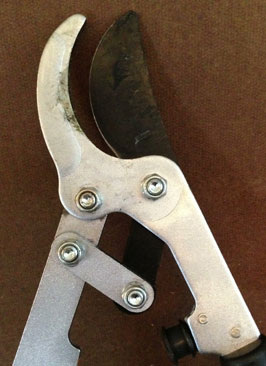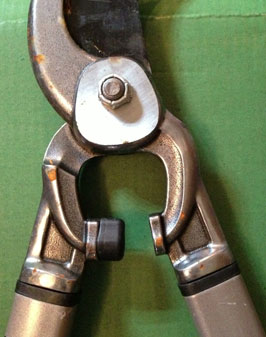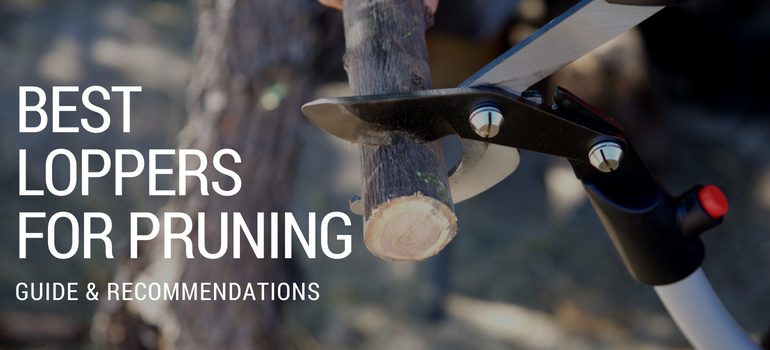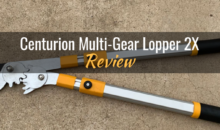Best Loppers for Pruning: Guide & Recommendations
We independently evaluate all recommended products and services. If you click on links we provide, we may receive compensation.
When you're faced with the tough job of cutting through branches over 1 inch in diameter, what do you use? Pruning shears are likely to break and a pruning saw may be overkill. But loppers are perfect!
Loppers are essentially pruners with long handles. They’re used mostly to prune out twigs and smaller branches (up to 2 inches in diameter, depending on the lopper). The long handles allow you to reach higher/farther and give you the leverage you need to cut thicker branches.
How to Choose the Best Loppers for You
Loppers come in a range of styles, sizes, and price points; what’s best for you depends on the kind of pruning you’ll be doing, your size and strength, and your budget. Pruning can be heavy, repetitive work so it’s important to buy the right loppers.
10 Important Considerations When Buying Loppers
To help you choose the best loppers for your needs, these are the features you should consider.
1. Type of Cutting Blades

Bypass lopper blades work similarly to scissors
There two basic types of loppers – bypass loppers and anvil loppers. Each is best for different types of pruning so we recommend choosing the one that best fits your pruning needs (or buying one of each).
- Bypass Loppers. These are the most commonly-used loppers, consisting of two blades that slide past each other like scissors. They typically provide the cleanest cut on live wood, allowing the plant to heal more quickly. However, they tend to get jammed when cutting dead, dry branches, which can bend the blade.
- Anvil Loppers. These have a one straight blade that cuts as it closes onto a flat edge or ‘anvil’ (think about it like a knife on a chopping board). Because the blade often crushes stems when cutting (unless the blade is extremely sharp), these are best used on dead wood or to trim back live wood before making a final, clean cut with bypass loppers. Because of their design, they can often cut thicker branches than bypass loppers.
If you’ll be cutting anything thicker than 2 inches, it’s best to use a pruning saw.
2. High Quality Steel Blades
Lopper blades are generally made out of steel, with the best option being blades made of high quality, hardened or carbon steel. These blades last longer and are less likely to nick, bend, or need frequent sharpening. Blades made from poorer quality material generally don’t hold a sharp edge, which means that pruning takes more effort and branches are easily damaged.
Lopper blades are sometimes covered with a non-stick coating that resists sap and other sticky materials. This is particularly handy if you’ll be pruning trees, like pine, that have especially sticky sap or pitch.
Another thing to look at is how closely the blades pass as you open and close them; the closer the better. Quality loppers will allow you to adjust the tightness of the cutting mechanism and ensure that the blades are tightly held against each other.
Be sure that the blades are flat, with no rough spots, burrs, or bends in the cutting edge or blade surface. It’s common for poorer quality blades to bend slightly, especially when used on thicker branches – this causes further damage with each pruning cut and can damage the branch you’re cutting.
3. Ratcheting, Compound Action, or Geared Cutting Mechanism

Compound action loppers have multiple moving parts
These types of mechanisms multiply force, allowing you to cut through a thick branch with less effort.
- Ratcheting Loppers. As you squeeze ratcheting loppers, they latch so you can release and squeeze again, performing the cut in easy steps rather than all at once.
- Compound Action Loppers. With multiple pivot points and moving parts, these loppers need to be opened further to get the blades around a branch.
- Geared Loppers. These loppers are exactly what they sound like – they have a gear mechanism at the fulcrum that gives you more leverage when you cut.
One thing to note with all of these types of loppers is that they typically weigh more than other loppers and, with all of the extra moving parts and more complicated cutting mechanism, there are more things that can go wrong.
4. Handle Length
Loppers come with a range of handle lengths, from shorter 15” or 18” loppers to 32” or longer. Lopper length affects the amount of leverage you have – longer loppers give you more leverage, making it easier to cut through thicker branches. The downside of longer handles is that they are more difficult to work with and tend to be heavier. Look for a length that you can comfortably handle – it’s not worth buying longer loppers if you can’t make clean pruning cuts with them.
5. Telescoping Handles
Telescoping lopper handles allow you to extend the handle length when you need more reach. This allows you to work with shorter, more easily controlled loppers most of the time, but still cut higher or farther branches when needed. These are a nice compromise for many situations, although be aware that they are usually heavier than a similar-size, non-telescoping lopper. Also, closely check the telescoping mechanism; some do not stay locked in place, especially when fully extended.
6. Grip

Grips come in a variety of lengths, shapes, and materials. Look for ones that are comfortable for you to hold.
Loppers come with a wide range of handle/grip sizes, shapes, and materials. Some are “ergonomically designed” to fit your hand, while others are made of softer material to cushion impact. We found that the softer, foam grips are most comfortable, but they’re also the most prone to damage. Handles with contoured grips may be most comfortable for some people, but try it out before buying as not everyone holds loppers the same way. Also check on the size of the grips; some are rather short, which limits hand placement on the handles when pruning.
7. Bumper
All better loppers have a bumper or other cushioning mechanism (usually near the blades) to prevent the handles from smashing together as you complete a cut. Make sure that the bumper prevents your hands from touching as you cut and try closing the loppers forcefully to see how well the bumper absorbs shock.
8. Availability of Replacement Blades and Parts

All quality loppers have a bumper to dampen shock when cutting.
Not all loppers can be taken apart for cleaning or sharpening, and many do not allow you to replace parts that break, wear out, or get damaged. On loppers, the blades can easily be damaged by poor pruning techniques (such as twisting the loppers while you cut), cutting branches that are too thick, or cutting deadwood with bypass pruners. Look for a pair of loppers that have a removable bolt holding the blades together; this typically means that the cutting blade is replaceable.
As a general rule of thumb, better quality loppers (generally those above $35) tend to have replacement parts (usually available directly from the manufacturer or distributor – check their websites for details) while the least expensive do not (it’s more cost-effective to simply replace the loppers).
9. Weight
Lopper weight is usually determined by the composition of the handles. At the lighter end, you’ll find aluminum and fiberglass handles, while steel loppers are generally heaviest and wooden handles fall in the middle. Steel is typically used for heavy-duty loppers with a larger cutting capacity, although the weight can make them uncomfortable and tiring to use. Aluminum is generally found in lighter-duty loppers, although they’re sturdy enough for everyday use.
10. Cutting Capacity / Power to Weight Ratio
Although some loppers can cut branches up to 2 inches in diameter, if the loppers are too heavy for you to use comfortably, the handles are too short for you to get enough leverage, or the handles are too long for you to open the loppers far enough to hold the branch firmly in the blades, then having a 2 inch cutting capacity doesn’t do you any good.
When looking at the “power” of loppers (cutting capacity), consider how heavy the loppers are relative to the power and weigh that against your strength and fitness. In many cases, it’s better to buy a lighter pair of loppers with a smaller cutting capacity and then use a pruning saw to cut thicker branches. Don’t be tempted to cut larger branches than you can easily manage; straining to push the lopper handles together usually results in twisting the loppers slightly, which can bend or even break the blades and/or handles, not to mention damage the branch.
Types of Bypass Loppers: What's the Difference Between Ratcheting, Geared & Compound Loppers?
We're often asked about the difference between the various types of loppers. What do they look like? How do they work? Which is right for specific types of pruning? So we put together this video explaining each type of lopper. Hope you find it helpful!
GPR Recommendations: Best Loppers
We reviewed a range of different loppers to find the best loppers for gardeners and home owners. To test the loppers, we had two licensed arborists and an experienced gardener take all of the loppers into the woods to cut both live wood and deadwood of varying widths and hardnesses on both trees and shrubs. The loppers we tested varied in price, style, material, brand, cutting mechanism, and more - but all were bypass loppers. Here are our results ...
Highly Recommended Loppers
No products found.
No products found.
| Florian Maxi Lopper If you’re looking for the crème de la crème of loppers, look no further than the Florian Maxi Lopper. It is extremely well crafted, strong, agile, and it can cut, and cut, and cut – all without requiring you to use a lot of force. >> READ OUR REVIEW |
Recommended Loppers
| Fiskars PowerGear2 Lopper At only 18 inches long, this lopper is a smaller version of its larger brethren. It can get into tight pruning spaces, makes clean cuts, stays sharp even after cutting deadwood, and is comfortable to hold. However, it only cuts up to 1 inch (not 1 ½ inch diameter material as claimed) and it would benefit from a bumper between the handles to absorb shock. >> READ OUR REVIEW |
|
| Fiskars 9168 Telescoping Power Lever Lopper Comfortable grips, telescoping handles provide good leverage. >> READ OUR REVIEW |
Not Recommended Loppers
Corona FL 3470 Compound Action Bypass Lopper with Extendable Handles, 1-1/2" Cut, 21" to 33" Length
Handles don't stay locked in place during use, making it almost impossible to work with.
Fiskars 9632 27-Inch PowerGear Bypass Lopper
Light-weight and sturdy BUT requires considerable strength and tears bark with each cut.
Corona Convertible Lopper & Pruner (BP 7450)
With the Convertible Pruner + Lopper, Corona tried to create a 2-in-1 tool that could take the place of both a pruner and a lopper. Unfortunately, it tries to be all things to all people and ends up not being particularly good at any one of them. Corona gave it a good shot, but missed the mark on this one.
>> READ OUR REVIEW
Last update on 2024-04-26 / Affiliate links / Images from Amazon Product Advertising API
Enjoyed This Review?
If you liked this review, please sign up for our email updates with reviews, how-to articles and gardening videos!













I enjoyed your article on loppers. I was just shopping for a Japanese lopper.
Thanks Sharee, glad you found it helpful 🙂
I have the Corona FL3470 bypass loppers – not used much, but the blade shows a bit of daylight when closed. which of the four bolts do I tighten./ loosen to get better alignment for a good cut? Thanks
Sad to note that you make no recommendations for RATCHETING anvil loppers. I need to take out small dead branches dangling over my vehicles in the drive. I have small hands -even for a woman. I have used a ratcheting anvil lopper to help a friend clear his deadwood, but he doesn’t really want to loan me his tool, bought at the state fair. I need to find a locally sourced one. You might consider reviewing this TYPE of lopper for appropriate purposes. ~thanks
Thanks for the suggestion. I’d love to test and review a ratcheting anvil lopper – unfortunately I haven’t found a company willing to let us test theirs! When I do, I’ll be sure to get a review published.
Hello and thanks for the interesting article on loppers and pruners.
I appreciate the criteria for choosing a lopper however It could be helpful to look at the “opening angle”: Fiskars loppers need almost 180 °, whereas Löwe (a brand worth testing by the way) opens 90° maximum, which should improve maneuvering in thickets and reduce force needed to close the loppers.
Since you recommend Wolf, I will probably get one, since they are reasonably priced.
Just out of curiosity – what about Burgon&Ball pruners?
Have a fantastic autumn in your garden! Gaby
Hi Gaby, and thanks for the suggestion. You’re right – the opening angle can make a huge difference. Some loppers are almost useless because you can’t get into tight spaces with them. I’d mention that the WOLF-Garten loppers do have to be opened fairly wide when the handles are fully extended (then again, pretty much any long-handled lopper would have this issue). We haven’t yet tested Lowe or Burgon & Ball loppers. I’d love to if they’re like to provide a sample for us to test! I’m also trying to get some Florian loppers to review.
I believe that the best loppers are the Stanley anvil loppers with a fixed yellow handle.
The second best loppers are the Aldi anvil loppers. Unfortunately they have a telescopic handle which becomes weaker once extended. The aluminium handle is a bit harder to spot amongst vegetation. Bright yellow is best. Green tools should not be used as they are to easily lost or mistakenly discarded. The Aldi anvil loppers are usually only $24.99 in Australia when on sale.
I have been using Wolf-garten tools forever. I am so happy to see that others have found them . The loppers and pruners are far and away the best tool and a great value
Hello Monica,
You’ve written a great in-depth article that I’m sure will assist in helping the average consumer make a better buying decision. After reading your article, I would have to agree with your list of features to look for in a lopper. However, I would prioritize weight, handle length and cutting capacity.
Additionally, I would recommend the Fiskars 32-Inch PowerGear Bypass Lopper instead of the 27 inch. As you mentioned in your article, the 27-inch requires considerable strength to cut as opposed to 32-inch. The 32-inch is made of lightweight aluminum which makes it lighter and stronger than most of the loppers on your list.
All in all, great article 🙂
Thanks for the feedback Mitch. You’re quite right – longer handles generally make it easier to cut through tough branches. Of course the trade-off is that you have to open the handles farther and that’s not always possible. We haven’t been able to test the 32-inch loppers yet so I can’t comment on them, but lightweight and strong is always a nice combination 🙂
I’ve used them all! I have 30 acres in Alabama and have been fighting intrusive privet (much worser problem than Kudzu, btw) for 3 years. I bought 2 Corona “by pass” loppers last year at 35 bucks a piece…both are easily bent after a couple of days of cutting/pulling etc…if I weren’t handy at re-bending, they would be thrown away…their limited lifetime warranty is NO GOOD for bent loppers. They say they are abused. But they aren’t. They use cheaper steel aluminum blend I guess…I’ve tried every kind! I’ve resorted to uprooting with tractor chains and digging up! Loppers are made for light work, period.
Thanks for sharing your experience, David. Sounds like you have quite a task on your hands with the privet and I’m glad you’ve found a removal method that works!
Our experience has been that any lopper will bend or fail when used for tasks other than making straight cuts through wood or through stems that are thicker than the maximum the loppers are rated for. Pulling, twisting, cutting roots, making steeply angled cuts, etc. will also ruin loppers – they simply aren’t made to do that kind of work. But use the right tool in the right way and a sturdy pair of loppers can definitely do heavy-duty work.
Have you ever tried and tested a FELCO two hand pruner?
Hi Gys, Yes we have. You’ll find our overall take on Felco products on the Best Pruners page (see it here).
Monica, with all due respect the andvil lopper is not only desirable for pruning live growth it is the best, by far, tool to use. In my 40+ year career in the landscape industry specializing in proper landscape plant care and pruning I have used most every prunner available. A properly sharpened andvil lopper cuts before it crushes. Hook and blade loppers are painfully slow and often shred smaller limbs rather than cut cleanly. Pruning a large number of plants would take many times longer with hook and blade as compared to andvil style loppers. Hook and blade are ok for larger limbs. The awkward , again painfully slow hook and blade prunners may be encouraging the use of gas powered shears that are so adversely affecting many home and commercial landscapes leading to the snow cone/ice cube style of shrub trimming so prevalent today. I haven’t even mentioned the even slower geared loppers ugh! 10’s of thousands of hand prunned shrubs support my method. Respectfully, Richard Whiteside Greensboro, NC
I own the WOLF-Garten Telescoping Bypass Lopper RR900T and would like to remind you that they are a compromise. They are a good overall tool if you need them occasionally or if you need a single tool that can be used in multiple situations.
However, they are a compromise, the telescopic handle means more shakiness(yet very stable compared to other telescopic handles) and more weight! I cut hundreds of olive trees every year and RR900T were unsuitable. I replaced them with LOWE 22.100 which are perfect. I mostly cut above head so need the extra length with all weight savings I can get. They are very strong and relatively light. The curved anvil seems to make branch penetration easier and to some degree prevents branches from slipping out of the jaw.
I would put the RR900T in the “serious hobbist gardener” class while the LOWE 22.100 would be a professional tool (the price is about the same).
Cannot comment on other loppers as I have not owned them although same downsides apply to all telescopic and flat-anvil loppers.
Thanks so much for your insights, Matej. We haven’t reviewed the LOWE lopper so can’t comment on that but, as you point out, telescoping loppers will always be a bit of a compromise. If you’ll be doing a lot of overhead pruning on a regular basis then a lightweight long-handled lopper would be a better choice. Most homeowners, however, won’t be doing that and the WOLF-Garten works extremely well for typical gardening tasks. Sounds like we need to test the LOWE loppers!
Some of the pruners I was looking at on other sites mentioned a ratio. How does that work? I would imagine that it means less strength involved somehow with regard to the diameter of the branch being pruned? Any tests yet on the anvil blade lopper yet? I am beginning a big pruning project on the trees edging our pastures.
Thank You.
I owned the Wolf loppers pictured above – the old style WITHOUT powercut gearing. They were excellent. Good power/ strength/ reach to weight, telescopic- so easier to climb a tree with, flat bolt heads, they never twisted, extension mechanism didn’t slip etc..
Then someone put them on the truck by mistake and they were cut up with a chainsaw.
I was very upset- then even more upset when I realised they were no longer available with a simple cutting head.
I may be mistaken but it looks like the gearing means you have to open the handles much wider for a given cut diameter ( not that convenient when you’re inside a tree or shrub! ) . Also geared heads are heavier and it looks bulkier to get into tight places.
To top it off it looks like they’ve put some grey rubber on the handles- the plastic was fine- rubber often goes weird and sticky after a while.
I’ve been getting by using the tiny chainsaw ( stihl ms150- a beaut!) or Felco secateurs but I’m missing those loppers.
I live in the UK but if anyone knows of a way I could get a pair of the old 900t’s or of an equivalent telescopic model please let me know!
If anyone has an ear at Wolf-Garten please tell them that fancier isn’t always better.
Hi Sophie,
I’m sorry to hear about the loss of your Wolf Garten Lopper’s. This is a UK link that might help you find a substitute: https://www.worldofwolf.co.uk/categories/cutting-range/loppers.
Let me know how you make out.
Thanks for your interest in the Gardening Products Review and your comments. We really appreciate them.
Regards,
Jack
I’m thinking of purchasing a Corona SL 6500 heavy duty 32″ 3″cut bypass lopper. Have any of your readers ever owned this lopper and if so I would like to hear their comments please
Thanks for mentioning the difference among different types of loppers. I like the bypass loppers for my gardening tasks.